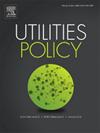英国上网电价制度的跨期不公平:跨地区赶超
IF 4.4
3区 经济学
Q3 ENERGY & FUELS
引用次数: 0
摘要
英国的上网电价(FIT)计划旨在通过为发电提供固定支付来促进住宅太阳能光伏(PV)项目,从而将太阳能光伏定位为家庭投资机会。本研究探讨了在FIT计划下,收入对太阳能光伏发电吸收的影响,并评估了其提供的财务回报的跨期公平性。使用来自323个地方政府区的数据,分析重点关注2011年和2015年的两个主要安装高峰,这两个高峰对应于电价的重大变化。研究结果显示,在第一个高峰期间,收入与太阳能光伏采用率呈正相关关系,但在第二个高峰期间呈负相关关系。这种转变表明,随着安装成本的下降,低收入地区开始赶上采用太阳能光伏。然而,通过估算这些时期的预期(事先)回报率,该研究发现,在两个峰值之间以及关税税率大幅降低之后,回报率都出现了大幅下降。这些结果表明,在高收入地区,早期采用者获得的财务回报明显高于后来采用者。该研究揭示了上网电价补贴计划中存在的一种跨期不公平,证实了需要更频繁、更及时地调整关税,以确保长期持续的投资激励。本文章由计算机程序翻译,如有差异,请以英文原文为准。
The intertemporal unfairness of the feed-in tariff scheme in the United Kingdom: Catching up across regions
The Feed-in Tariff (FIT) scheme in the UK was designed to promote residential solar photovoltaic (PV) projects by offering fixed payments for electricity generated, thereby positioning solar PV as an investment opportunity for households. This study investigates the role of income in shaping the uptake of solar PV under the FIT scheme and assesses the intertemporal fairness of the financial returns it provides. Using data from 323 local authority districts, the analysis focuses on two major installation peaks in 2011 and 2015, which correspond to significant changes in tariff rates. The findings reveal a positive relationship between income and solar PV adoption during the first peak, but a negative relationship in the second. This shift suggests that as installation costs declined, lower-income regions began to catch up in adopting solar PV. However, by estimating the expected (ex ante) rates of return across these periods, the study identifies a substantial decline in returns, both between the two peaks and following sharp reductions in tariff rates. These results indicate that early adopters in higher-income regions achieved significantly higher financial returns than those who adopted later. The study reveals a form of intertemporal unfairness embedded in the FIT scheme, confirming the need for more frequent and responsive tariff adjustments to ensure consistent investment incentives over time.
求助全文
通过发布文献求助,成功后即可免费获取论文全文。
去求助
来源期刊

Utilities Policy
ENERGY & FUELS-ENVIRONMENTAL SCIENCES
CiteScore
6.80
自引率
10.00%
发文量
94
审稿时长
66 days
期刊介绍:
Utilities Policy is deliberately international, interdisciplinary, and intersectoral. Articles address utility trends and issues in both developed and developing economies. Authors and reviewers come from various disciplines, including economics, political science, sociology, law, finance, accounting, management, and engineering. Areas of focus include the utility and network industries providing essential electricity, natural gas, water and wastewater, solid waste, communications, broadband, postal, and public transportation services.
Utilities Policy invites submissions that apply various quantitative and qualitative methods. Contributions are welcome from both established and emerging scholars as well as accomplished practitioners. Interdisciplinary, comparative, and applied works are encouraged. Submissions to the journal should have a clear focus on governance, performance, and/or analysis of public utilities with an aim toward informing the policymaking process and providing recommendations as appropriate. Relevant topics and issues include but are not limited to industry structures and ownership, market design and dynamics, economic development, resource planning, system modeling, accounting and finance, infrastructure investment, supply and demand efficiency, strategic management and productivity, network operations and integration, supply chains, adaptation and flexibility, service-quality standards, benchmarking and metrics, benefit-cost analysis, behavior and incentives, pricing and demand response, economic and environmental regulation, regulatory performance and impact, restructuring and deregulation, and policy institutions.
 求助内容:
求助内容: 应助结果提醒方式:
应助结果提醒方式:


